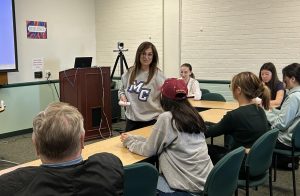MC event explored virtual world of real relationships
March 18, 2014
Since the dawn of the internet, online interactions have become increasingly popular. Professor Daniel Vieira shows off this virtual meeting place and the relationships it creates in his lecture “Fun and Romance in Virtual Worlds: Creation of Primary Relationship”
A tertiary group is a group in which no face to face contact exists between the people involved in a relationship. This is becoming more and more common as the internet continues to allow people from around the world to meet with the click of a mouse.
This virtual form of interaction was the topic of Sociology Professor Daniel Vieira’s thought provoking lecture “Fun and Romance in Virtual Worlds: Creation of Primary Relationship” which is part of Moorpark College’s Year of Technology and Humanity. The lecture, which had a full house, showed the various aspects of what makes a virtual world and raised some interesting questions about the future and how society should react to this growing “second” reality.
“Professor Vieira’s lecture was timely, informative, and thought provoking for all who attended,” said Moorpark College Interim President Dr. Bernard Luskin via email.
Vieira began by explaining the differences between a primary and secondary relationship. Basically, a primary relationship is a close, intimate relationship similar to family, close friends, and lovers, while a secondary relationship is more in the line something large group and business like, similar to work or school.
As mentioned earlier, a tertiary group is one that does not involve physical contact between its members. Thus relationships are formed based on little “real” knowledge of an individual and more on who the person is online. Often, these relationships grow into something similar to a primary relationship.
One of the biggest creators of these tertiary groups is a popular MMO (massive multiplayer online) called Second Life. The video game allows a user to create an avatar that either resembles them self or to take on any form they wish, even an orca whale.
“A lot of people don’t really understand that there’s this entire online community where people are making lives and worlds for themselves,” says Vieira. In this world, normal tertiary relationships are taking on the characteristics of primary relationships.
In these virtual worlds, people’s avatars can go out shopping, dancing, eating, etc. Avatars can also get married, have children (either in the form of a doll that grows or by adopting another user’s childlike avatar) and grieve for an avatar who has died or disappeared.
“They are literally creating an actual life in a world that some people would say does not exist,” says Vieira. These kinds of MMO’s give people the opportunity to be anyone they want to be and meet new people all while being anonymous.
Vieira ends the lecture with some thought provoking questions on the implications these second life virtual realities have on social norms. Is having a relationship online while in a relationship in the real world considered cheating? Furthermore, how is one’s self to be perceived in this virtual reality verses the real worlds self?
“Is the avatar the same person as me, an extension of me, or a different person in a different world?” asks Vieira in his lecture.
Vieira’s mind boggling lecture presented a virtual world where essentially anything can be possible for its users and where tertiary relationships become primary relationships. Overall the sociological implications of fun and romance in virtual worlds are a constantly growing question, just as the technology behind it is a constantly growing phenomenon.
It’s a technology we don’t have a culture for, says Vieira, and with all the questions that it raises it’s something that we need to talk about.







